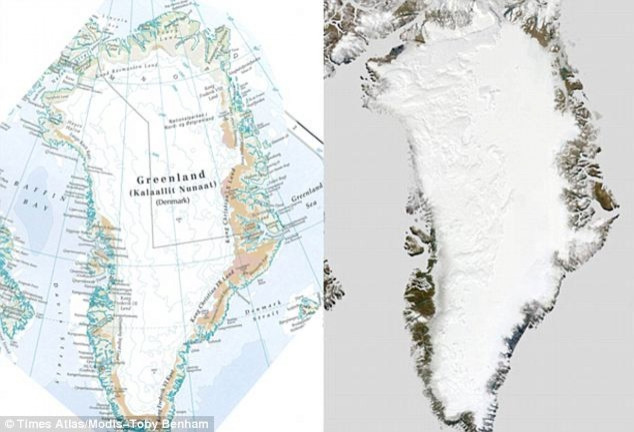New Times Atlas Grossly Exaggerates Greenland Ice Loss

The Times Atlas of the World claims to be the world's most authoritative source for cartography. So, when they quite publically announced that their new edition reflected a 15 percent decrease in Greenland's ice cover as green and ice-free, several scientists were confused.
Leading UK polar scientists came out, claiming that the Times Atlas of the World was absolutely over exaggerating and wrong to assert that it had to re-draw its map of Greenland due to climate change.
Updating the 1999 version, the 13th edition of the comprehensive atlas was released last week at a cost of $237 (£150). It includes a number of revisions made for reasons of environmental change like the drying up of rivers such as the Colorado, the shrinking of inland waterways like the Dead and Aral Seas, and the break-up of some Antarctic ice shelves.
However, it's the bold opening statement on the atlas' glossy publicity sheet that's drawing the biggest criticism.
For the first time, the new edition of the (atlas) has had to erase 15 percent of Greenland's once permanent ice cover -- turning an area the size of the United Kingdom and Ireland 'green' and ice-free.
This is concrete evidence of how climate change is altering the face of the planet forever -- and doing so at an alarming and accelerating rate.
Scientists from the Scott Polar Research Institute at Cambridge University say that these figures are absolutely wrong, and that ice has melted by less than one percent during that time.
We are not saying in any way that climate change and the loss of the ice sheet is not going on, Professor Liz Morris, a senior associate at the institute, told The Telegraph. The danger is if people quote these absurd figures the next thing that happens is climate change skeptics say scientists are making daft claims. We are not. It is the publicity people.
Morris worries that cartographers have muddled satellite data on elevation with ice cover and assumed that below a certain level, there was no ice. However, the ice sheet carries on to the shore in many areas.
In a letter addressed to The Times Atlas, the team at the Scott Polar Research Institute agrees that the Greenland ice cover is reducing, but discounts the astonishing rate.
A 15% decrease in permanent ice cover since the publication of the previous atlas 12 years ago is both incorrect and misleading.
Numerous glaciers have retreated over the last decade. Because of this retreat, many glaciers are now flowing faster and terrain previously ice-covered is emerging along the coast -- but not at the rate suggested.
Recent satellite images of Greenland make it clear that there are in fact still numerous glaciers and permanent ice cover where the new Times Atlas shows ice-free conditions and the emergence of new lands.
We do not know why this error has occurred, but it is regrettable that the claimed drastic reduction in the extent of ice in Greenland has created headline news around the world.
There is, to our knowledge, no support for this claim in the published scientific literature.
Many of the institute's staff is intimately involved in the research of climate change's impact across the Arctic.
According to the researchers, the volume of ice contained in the Greenland ice sheet has decreased by roughly 200 cubic km per year, or a decrease of about 0.1 percent by volume over 12 years.
The Times is published by Times Books, an imprint of HarperCollins, which is in turn owned by Rupert Murdoch's News Corporation.
A spokeswoman for Times Atlas defended the 15 percent figure and the new map.
We are the best there is. We are confident of the data we have used and of the cartography. We use data supplied by the US Snow and Ice Data Centre (NSIDC) in Boulder, Colo. They use radar techniques to measure the permanent ice. We have compared the extent of the ice surface in 1999 with that of 2011. Our data shows that it has reduced by 15 percent. That's categorical, she said.
You will always have a level of generalization. But we have compared like with like. The same criteria were applied to the 1999 data to that of 2011.
We are not saying that all of the ice loss is due to climate change. It is the lion's share but the data has improved over the period.
The incident echoes the 2010 row when the UN's climate science body admitted that a claim made in its 2007 report - that Himalayan glaciers could melt away by 2035 - was unfounded. It was revealed that the claim was not based on peer-reviewed science, but rather a media interview with a scientist.
READ ALSO:
Dozen New Species of Night Frogs Discovered in India [PHOTOS]
Mysterious Wheel Patterns in Middle East Resemble Peru's 'Nazca Lines' [PHOTOS]
© Copyright IBTimes 2024. All rights reserved.






















